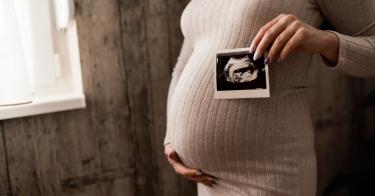Olivia Maurel was 30 years old when an ancestry DNA test confirmed what she had known all along: she is the product of a costly commercial surrogacy contract. In Olivia’s case, the woman that her parents paid to gestate and birth Olivia is also her biological mother.
In a recent article with Daily Mail, Olivia shared how “becoming a parent myself—entirely naturally, in my mid-20s—has only crystallized my view. The sacred bond between mother and baby is, I feel, something that should never be tampered with.” After going viral for her testimony before the parliament of the Czech Republic, Olivia now campaigns for the universal abolition of surrogacy.
In the United States, only three states prohibit or do not enforce commercial surrogacy contracts. One of the states, Michigan, is poised to overturn their ban on surrogacy-for-pay through a nine-bill “Access to Fertility Healthcare Package.” Legislators are tying their efforts to the national conversation on in vitro fertilization in hopes of garnering additional support. I detail the concerns with this legislation in detail here, but suffice it to say it undermines motherhood by reducing the intimate relationship between a woman and the child she carries to a highly-lucrative rental agreement.
Several well-respected researchers and pundits claim that surrogacy does not harm children. Yet we know very little about its long-term impact on a child’s psychological well-being.
>>> Biden Was Right: Children Aren’t “Baggage.” He Should Tell That to Advocates of Commercial Surrogacy
Most of those who assert that surrogacy is psychologically harmless rely on a longitudinal study by Susan Golombok, Professor Emerita of Family Research, and former Director of the Centre for Family Research at the University of Cambridge. She is the author of We Are Family (2020), a synthesis of 40 years of research on non-traditional family structures—same-sex, single parent by choice, and the use of all forms of assisted reproductive technology, including third-party conception. She concludes that such arrangements pose no additional harm and can benefit children.
Professor Golombok’s “Families Created Through Surrogacy” study began in 2003 and assessed parental and child psychological adjustment at ages 1, 2, 3, 7, 10, and 14. The impact of this single longitudinal study on both public opinion and policy cannot be overstated. To date, it is the only study that specifically examines the surrogate-born child’s psychological adjustment, as well as the only study to do so over an extended period. It is also the only research on child psychological well-being that policymakers in New York used to argue for the legalization of commercial surrogacy.
Professor Golombok’s sample of surrogacy families comes from the General Register Office of the United Kingdom for National Statistics (ONS) and from the UK’s “Childlessness Overcome Through Surrogacy” (COTS) agency. The original sample included 42 surrogate-born children but declined to a mere 28 children by age 14. The study relied on a group of families formed through egg donation and children born of natural conception to serve as the comparison groups.
With such a small sample size, and some families participating inconsistently year-to-year, the study itself runs the risk of selection bias and non-representative outcomes. The study lumps both children born through gestational surrogacy and traditional surrogacy together, too. This means some surrogates are both the genetic mother and the child's gestational mother.
Additionally, only altruistic surrogacy is legal in the UK, so these arrangements do not involve surrogates who legally receive an additional sum of money, beyond generous reimbursements. For context, surrogacy-for-pay brings in an additional $25,000 to $70,000 in the United States, which may affect how a child views his or her conception, gestation, and birth.
In each study, the scholars rely on the mother’s own assessment of the child’s well-being. It is not until age 14 when scholars begin to directly ask children questions to assess their self-esteem.
Overall, Professor Golombok concludes that children born from surrogacy agreements of any sort do as well, if not better, psychologically than their natural-born peers.
For ages 1, 2, and 3, Professor Golombok finds that parents in surrogacy families showed “greater warmth and attachment-related behavior” than natural-conception parents. One explanation for this, as Professor Golombok’s notes, is that “parents of children born in this way [may] make a greater attempt than parents of naturally conceived children to present their families in the best possible light.” Such a bias seems likely, given that parents may feel the subconscious desire to justify their uncommon path to parenthood.
By age 7, both surrogate-born children and donor-conceived children in the control group were doing noticeably worse than their natural-born counterparts. This is the point when many children learned of their biological or gestational origins. The scholars note that this corresponds with adoption literature as the period in a child’s life when they begin to comprehend the loss of one or both biological parents. What goes unnoted, however, is that unlike adoption, surrogacy is the intentional creation of a child for the express purpose of removing the child from his or her gestational and/or biological parent(s).
Beginning at age 10, scholars report that the child’s psychological adjustment returns to a relatively normal state compared to the natural-born children, but the study itself reports little data compared to previous papers. By age 14, when the study concludes, the remaining 28 children seem to fare about the same as natural-born children, despite slightly more psychological problems reported.
Despite these methodological limitations, Professor Golombok’s data from this longitudinal study remains the basis of child psychological adjustment research on surrogacy. Examples of this may be found in prominent pieces such as Vanessa Brown Calder's review of surrogacy at the Cato Institute or Cremieux Recueil's widely shared Substack with Aporia Magazine. Their conclusions that surrogacy confers “no harm” to the psychological well-being of the child are premature, to say the least.
In Calder’s article, she cites three studies in her discussion on the psychological well-being of surrogate-born children. A quick review of each study shows that these authors rely solely on Professor Golombok’s longitudinal study data to draw their conclusions.
In Recueil’s Substack, "Surrogacy: Looking for Harm," he primarily relies on Golombok’s work to claim that “psychological harm appears to be minimal.” Again, this statement is premature and formed on limited data primarily from her longitudinal study. The other five citations in the “Psychological Outcomes for Kids” section tell us little about the psychological well-being of surrogate-born children.
>>> Why the IVF Industry Must Be Regulated
Recueil twice cites “Are the Children Alright? A Systematic Review of Psychological Adjustment of Children Conceived by Assisted Reproductive Technologies,” from 2022. Of the 11 studies that examine the intersection between surrogacy and child psychological outcomes, they fall into three categories:
- the longitudinal study by Professor Golombok
- child outcomes compared with other children born from assisted reproductive technology, not compared with natural-born children
- studies that examine the impact of non-traditional parenting types, such as lesbian mothers or gay fathers, on the well-being of the child. The impact of surrogacy is not directly assessed; it is simply mentioned as a requirement for male-to-male family formation. Of these three categories, the only studies that directly address the claims that Recueil makes are the research of Professor Golombok, which he already cited before these additional studies.
Hence, the widespread claim that surrogacy does not harm the psychological well-being of children primarily relies on a single longitudinal study of 42-to-28 surrogate-born children by the intended mother’s own assessment. That’s it.
This isn’t to say we should discard Professor Golombok’s study. But honest scholars and lawmakers should be far more modest in claiming that surrogacy does not harm the psychological well-being of children.
The most accurate conclusion regarding the psychological adjustment of surrogate-born children is that we do not have enough data to draw a conclusion either way, especially not in favor of surrogacy itself. When the well-being of children is at stake, lawmakers and researchers should employ the utmost scrutiny before advocating for any form of childbearing.
Children rightly desire to please their parents, and there are few conversations more complicated than questioning the method one’s parents chose to bring one into the world. There is reason to believe that many surrogate-born children will not have the emotional or mental maturity to understand their conception and gestation until they are much older.
There is a huge difference between no harm and no known harm. Regardless of one’s stance on surrogacy, we should be able to agree that we need more data and reporting requirements to enable researchers to assess the impact of surrogacy contracts on the well-being of children. In my view, a single six-part longitudinal study does not justify this practice.
This piece originally appeared in the Institute for Family Studies





